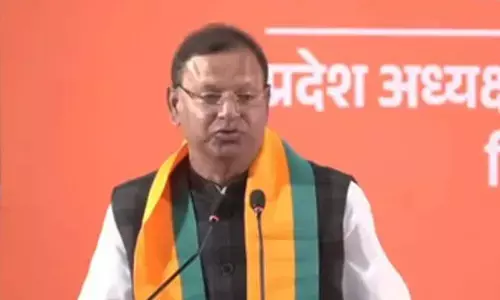The Athirapally 'conundrum' that hurts Kerala time and again
 Athirapally Hydro Electric Project
Athirapally Hydro Electric ProjectThe Athirapally Hydro Electric Project has a history from the 1980s. In 2005, Kerala approved this project based on a flawed Environment Impact Assessment (EIA) study conducted by Water and Power Consultancy Services (India) Ltd (WAPCOS)
The Athirapally Hydro Electric Project has a history from the 1980s. In 2005, Kerala approved this project based on a flawed Environment Impact Assessment (EIA) study conducted by Water and Power Consultancy Services (India) Ltd (WAPCOS). However, the Kerala High Court quashed the clearance and ordered another public hearing.
The project located in Thrissur district continues to attract controversy and public attention as it is a culturally aesthetically beautiful area with high biodiversity. The Kerala State Electricity Board (KSEB) had proposed to build a 163 MW hydro project at the Athirapally waterfalls on the Chalakudy river.
The Union MoEF sanctioned clearance for this project in 2007, which attracted the opposition of environmentalists, as it would destroy the valuable and pristine ecosystem and seriously affect the tribal population. Around 28.5 hectares of riparian forest area will be under threat of submergence.
The project would destroy the scenic beauty of the area that attracts countless number of tourists. As a scientific (EIA) study is mandatory for any project that is likely to impact the ecosystem, the MoEF gave clearance for the project in 1998 without a public hearing.
So, the Kerala High Court in 2001 directed the KSEB to follow all procedures for clearance and a public hearing was held in February 2002, when environmentalists and local communities were against it.
Subsequently, the Kerala High Court cancelled the clearance to have a more meaningful public hearing. The Western Ghats Ecology Expert Panel (WGEEP), led by Madhav Gadgil rejected this proposal as it was not viable and would destroy the rich ecosystem.
The subcommittee of the expert appraisal committee for river valley and hydroelectricity projects in 2007 also suggested that the project would affect the livelihood of local people who depend on income from tourism in the region.
The government of Kerala gave an assurance in the Kerala Legislative Assembly that it would not go ahead with the project unless there was consensus for the project, and it has remained a dormant issue. In fact, the present ruling Left Democratic Front manifesto in 2016 promised to take steps to protect the issues and improve the water flow.
However, the present statement by the State Electricity Minister M M Mani runs contrary to it, where a sanction from the Centre was sought by the KSEB, following which rumblings began in various quarters.
The tribal Panchayat of the Athirapally area also opposes the project as it will be against their interest and the Forest Rights Act. Besides it would fragment the habitat, impact flora and fauna in incalculable ways.
The biodiversity we see today is the result of billions of years of evolution, shaped by natural processes, through time. It forms the web of life of which we are an integral part and upon which we so fully depend.
Biodiversity contributes utilisation benefits, ecosystem services, ethical, moral benefits and aesthetic value. It is also the basis of sustainable livelihoods.
According to the UN FAO, 40 per cent of the world's economy is based directly and indirectly on the use of biological resources. Biodiversity is under serious threat due to human activities. The need to sustain biodiversity vis a vis economic growth and development is being increasingly recognised.
Kerala experienced disastrous floods in 2018, severe floods again in 2019, followed by several landslides in the Western Ghats (WG) region resulting in the fragmentation of the ecosystem and loss of hundreds of lives and livestock, not to mention the wildlife.
Conserving natural terrestrial, fresh water and marine ecosystems and restoring the degraded ecosystem is essential for the overall goals of both the UN Convention on Biological Diversity (CBD) and the United Nations Framework Convention on Climate Change (UNFCCC).
The environment plays a key role in the global carbon cycle and in adapting to climate change, while also providing a wide range of services that are essential for human wellbeing and the achievement of the Millennium Development Goals (MDGs).
Loss of biodiversity is caused by a range of drivers.
A driver is any natural or human induced factor that directly or indirectly causes change in an ecosystem. Habitat alteration renders entire areas functionally unable to support the species.
Clearing of forests for agriculture, changes in riverine habitat to lacustrine (reservoir) habitat by the construction of hydroelectric projects on the rivers, mining, logging etc. are some examples of destruction and fragmentation.
The proposed project will be a threat which involves partial loss of 125 square kms area of the Peechi-Vazhani Wildlife Sanctuary in Thrissur district. This falls in one of the 25 bio-diversity hotspots in the world in the WG. India is one of the early signatories to the CBD.
The Indian Forest Act 1927 and the Forest (Conservation) Act 1980 deal with management of forests and conservation of forest land respectively. The Wildlife (protection) Act 1972 and the Biodiversity Act 2002 are for the protection of wild animals, birds and plants and the ecosystem.
The construction of a dam at Athirapally will be against all these Acts and Regulations. The WGEEP named Athirapally as one of the 18 eco-sensitive localities in the State.
Both the WGEEP and the HLWG suggested not to go in for new dam construction. Former Principal Chief Conservator of Forests, T M Manoharan who was also the Chairman of KSEB, opposed the project citing the harm it would cause to the environment and ecology of the area.
Former Union Minister of Environment Jairam Ramesh had said that this project would be a "perfect recipe for ecological disaster".
About a million people were evacuated from the central Travancore - Cochin region during the 2018 flood disaster in Kerala. That was followed by a second flood in 2019. Both the floods caused irreparable damage to the ecosystem and fragmentation of WG following hundreds of landslides.
The Centre declared it a level 3 calamity or "calamity of severe nature". The damage to property was estimated to be over Rs 40,000 cores in several districts in the WG region.
The repeated droughts alternated by floods in Kerala are a manifestation of climate change. The State should value The Economics of Ecosystem and Biodiversity (TEEB) when engaged in the Rebuild Kerala Initiative.
A "Harithakerlam" (green Kerala) alone can bring about the "Gross Domestic Happiness" (GDH) along with an improved GDP in the proposed "Nava Keralam". It would be in the larger interest of the ecology of the state and conservation of WG that we no longer consider this devastating project.
(The writer is former Chairman of the Kerala State Biodiversity Board. He is a respected environmentalist. The views expressed are personal.)



















